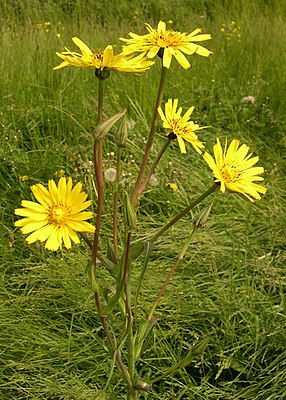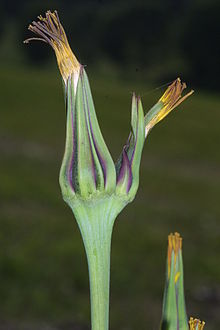Meadow goat beard
| Meadow goat beard | ||||||||||||
|---|---|---|---|---|---|---|---|---|---|---|---|---|

Meadow goat whiskers ( Tragopogon pratensis ), habitus |
||||||||||||
| Systematics | ||||||||||||
|
||||||||||||
| Scientific name | ||||||||||||
| Tragopogon pratensis | ||||||||||||
| L. |
The Meadow Salsify ( Tragopogon pratensis ) is a form rich species of the family of the daisy family (Asteraceae).
features
The perennial , herbaceous plant grows up to 70 cm high. Their juicy parts of the plant contain milky sap . The smooth stem , slightly swollen at the top and hollow on the inside, grows from the fleshy taproot . The surrounding, up to 50 cm long, grass-like, alternate, bluish green and smooth-edged leaves are half-stem-encompassing, narrowly linear or lanceolate, glabrous and tapering to a point. A whitish stripe runs lengthways through the middle of the leaf. The leaves are often bent or kinked from the middle downwards.
The plant blooms from May to August. Their inflorescences open around eight o'clock and close again around noon. They are mainly pollinated by beetles and flies. The 35–50 mm wide, flat flower heads of the plant sit on relatively long, bare, leafy, axillary stems that do not or only slightly thicken towards the head. The flower heads, which are 4 to 7 cm in size, depending on the subspecies, are composed of yellow ray flowers and are bordered by eight pointed bracts , which in the nominate form Tragopogon pratensis subsp. pratensis are about as long as the ray-florets and constricted above the base. The inner bracts in particular are mostly blackish-sooty due to hair . Characteristic are the brown-purple stamens at the top , which give the head a speckled appearance. The faded, withered ray florets from the collapsed bracts protrude like a "goatee" from the former flower. This gave the plant its name.
The 15 to 25 mm long (including the beak), smooth-edged fruits of the wild goat beard are long beaked. The feathery paperboard on it serves as a flight organ and gives the seeding plant the "dandelion" look that is typical for many composite plants.
The number of chromosomes for three subspecies occurring in Central Europe ( Tragopogon pratensis subsp. Pratensis , subsp. Minor and subsp. Orientalis ) is 2n = 12.
ecology
The wild goat beard is usually a biennial semi-rosette plant, rarely hibernating or perennial annually (then possibly as a rhizome - geophyte ). It has a deep tap root and carries milky sap . Its flowers are "cup flowers of the Leontodon type". They are only open in the morning and only when the weather is nice. In the Eastern Meadow Goat ( Tragopogon pratensis subsp. Orientalis ) the flowers are open until 11 a.m., in the Common Meadow Goat ( Tragopogon pratensis subsp. Pratensis ) until 2 p.m. There are 20 to 50 individual flowers per cup. The corolla tube of the marginal flowers is 6 to 7 mm long, that of the middle 5 mm long. As pollinators are bees , butterflies and Hummelschweber in question. Spontaneous self-pollination is made possible by the fact that the two scar branches curve around each other in a spiral and touch the purging hairs to which pollen can still adhere. The fruits are achenes with "parachutes" up to 4 cm wide. They spread as little umbrella flyers. The top of the umbrella is particularly dense due to the interweaving of the cardboard hair. It is also possible to spread it as a water-like and as a Velcro stick, since the five main pappus rays are rough. Since the screen breaks off easily, a random spread is also possible.
distribution
The species is native to Europe, occurs as far as the Urals, but is largely absent in Northern Europe. Their original occurrences in Asia are in Turkey, Kazakhstan, Siberia and Mongolia. In North America, New Zealand, Argentina and Hispaniola, the goat beard is a neophyte .
You can find the goat's beard widespread in greasy meadows, and more rarely in weed meadows and fallow land along the way. It prefers fresh, nutrient- and base-rich, medium to deep soils. He avoids waterlogging, but loves summer warmth. According to Ellenberg , it is a half-light plant, a weak acid to weak base pointer and an association character of the smooth oat meadows from the association Arrhenatherion. The subspecies Tragopogon pratensis subsp. orientalis rises in the Allgäu Alps in the Tyrolean part of the Rotwand up to an altitude of 2000 meters.
Systematics
Within the family, the wild goat belongs to the subfamily Cichorioideae, Tribus Lactuceae and Untertribus Scorzonerinae. Several clans belong to the Wiesen-Bocksbeard. Depending on the author, these are understood as subspecies or as separate minor species.
- Big Meadow Salsify ( Tragopogon pratensis . Subsp leiocarpus (Trnka) Greuter , Syn .: Tragopogon orientalis . Subsp leiocarpus Trnka , Tragopogon pratensis subsp. Grandiflorus (Saut) HPFuchs. [Non Döll 1843] Tragopogon grandiflorus Saut. ): He comes in Germany, the Czech Republic, Slovakia and Liechtenstein.
- Eastern meadow goatee ( Tragopogon pratensis subsp. Orientalis (L.) Čelak. , Syn .: Tragopogon orientalis L. ) The large meadow goatee and the eastern meadow goatee are summarized by Fischer 2005 in a type of Tragopogon orientalis . The eastern goat beard is widespread in Europe and the Middle East, but does not occur in northern Europe.
- Small meadow goat whiskers ( Tragopogon pratensis subsp. Minor (Mill.) Wahlenb. ): This subspecies is often associated with forms of the subsp. confused pratensis . It occurs in Spain, France, Italy, Great Britain, Ireland, Belgium, Luxembourg, Switzerland, Germany, the Czech Republic, Norway, Sweden and Denmark.
- Common goat whiskers ( Tragopogon pratensis subsp. Pratensis or Tragopogon pratensis s. Str.): It occurs in Europe and the Middle East. Its distribution area originally includes the countries Spain, France, Italy, Belgium, Luxembourg, the Netherlands, Germany, Austria, Czech Republic, Poland, Slovakia, Switzerland, Liechtenstein, Denmark, Norway, Sweden, Finland, the Baltic States, Russia, Belarus, Serbia, Croatia, Bosnia-Herzegovina, Albania, Macedonia, Montenegro, Bulgaria, Greece, Ukraine, European and Asian Turkey.
- Tragopogon pratensis subsp. hayekii (Soó) Ciocîrlan (Syn .: Tragopogon transsilvanicus Hayek [non Schur 1866]): It occurs in Greece, Macedonia and Romania.
use
The goat's beard is edible in all parts. The shoot of the young plant provides a vegetable that is reminiscent of asparagus . The root can be prepared in a similar way to black salsify. The leaves can be used raw or cooked. In Turkey it is known as yemlik, where it is often collected in spring and either dipped raw in salt, eaten as a salad or cooked.
literature
- Siegmund Seybold (Ed.): Schmeil-Fitschen interactive (CD-Rom), Quelle & Meyer, Wiebelsheim 2001/2002, ISBN 3-494-01327-6
- Erich Oberdorfer : Plant-sociological excursion flora for Germany and neighboring areas . 8th edition, Ulmer-Verlag, 2001, ISBN 3-8001-3131-5
- Heinz Ellenberg : Vegetation of Central Europe with the Alps from an ecological, dynamic and historical perspective. 5th, heavily changed and improved edition. Ulmer, Stuttgart 1996, ISBN 3-8001-2696-6 .
- Ruprecht Düll , Herfried Kutzelnigg : Pocket dictionary of plants in Germany. A botanical-ecological excursion companion to the most important species. 6th, completely revised edition. Quelle & Meyer, Wiebelsheim 2005, ISBN 3-494-01397-7 .
- Margot Spohn, Marianne Golte-Bechtle: What is blooming there? Encyclopedia, Kosmosverlag, 2005
Web links
- Meadow goat beard. In: FloraWeb.de.
- Meadow goat beard . In: BiolFlor, the database of biological-ecological characteristics of the flora of Germany.
- Profile and distribution map for Bavaria . In: Botanical Information Hub of Bavaria .
- Tragopogon pratensis L. s. st. In: Info Flora , the national data and information center for Swiss flora . Retrieved June 29, 2016.
- Tragopogon pratensis subsp. orientalis (L.) Celak. In: Info Flora , the national data and information center for Swiss flora . Retrieved June 29, 2016.
- Tragopogon pratensis subsp. minor (Mill.) Hartm. In: Info Flora , the national data and information center for Swiss flora . Retrieved June 29, 2016.
- Distribution in the northern hemisphere according to Hultén
- Thomas Meyer: pratense data sheet with identification key and photos at Flora-de: Flora von Deutschland (old name of the website: Flowers in Swabia )
- Profiles: [1] [2]
- Pictures: [3] [4] [5]
Individual evidence
- ↑ a b c d Gunter Steinbach (Ed.), Bruno P. Kremer u. a .: wildflowers. Recognize & determine. Mosaik, Munich 2001, ISBN 3-576-11456-4 , p. 70.
- ↑ a b Erich Oberdorfer : Plant-sociological excursion flora for Germany and neighboring areas . With the collaboration of Angelika Schwabe and Theo Müller. 8th, heavily revised and expanded edition. Eugen Ulmer, Stuttgart (Hohenheim) 2001, ISBN 3-8001-3131-5 , pp. 983-984 .
- ↑ a b Tragopogon in the Germplasm Resources Information Network (GRIN), USDA , ARS , National Genetic Resources Program. National Germplasm Resources Laboratory, Beltsville, Maryland. Retrieved April 15, 2018.
- ↑ Distribution map
- ↑ Erhard Dörr, Wolfgang Lippert : Flora of the Allgäu and its surroundings. Volume 2, IHW, Eching 2004, ISBN 3-930167-61-1 , p. 666.
- ↑ Schmeil-Fitschen, FloraWeb
- ^ Manfred A. Fischer , Wolfgang Adler, Karl Oswald: Excursion flora for Austria, Liechtenstein and South Tyrol. 2nd, improved and enlarged edition. State of Upper Austria, Biology Center of the Upper Austrian State Museums, Linz 2005, ISBN 3-85474-140-5 .
- ↑ a b c d e f Werner Greuter (2006+): Compositae (pro parte majore). - In: W. Greuter & E. von Raab-Straube (ed.): Compositae. Euro + Med Plantbase - the information resource for Euro-Mediterranean plant diversity. Datasheet Tragopogon pratensis In: Euro + Med Plantbase - the information resource for Euro-Mediterranean plant diversity.
- ↑ Wolfgang Bomble: Tragopogon - salsify (Asteraceae) in North Rhine-Westphalia . Yearbook of the Bochum Botanical Association. Vol. 4, 2013, pp. 262–269 ( PDF 1.6 MB)


